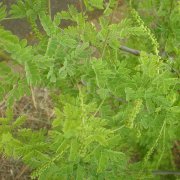Care of the tree Acacia greggii or Wait-a-minute bush |
|
The Acacia genus, of the Fabaceae family, includes some 1,200 species of shrubs and trees native to Australia, Africa, Asia and South America. Some species of the genus are: Acacia greggii, Acacia dodonaeifolia, Acacia dealbata, Acacia cultriformis, Acacia longifolia, Acacia hebeclada, Acacia tortilis, Acacia truncata, Acacia luederitzii, Acacia saligna, Acacia paradoxa, Acacia tetragonophylla, Acacia melanoxylon, Acacia karoo, Acacia iteaphylla, Acacia pendula. Common names: Wait-a-minute bush, Catclaw acacia, Catclaw mesquite, Wait-a-bit tree and Paradise flower. This species is native to northern Mexico and southwestern USA. They are small trees or large bushes with a round tree top and spines similar to cat's nails; these plants do not exceed 10 meters (32.80 feet) in height. They have pinnate leaves with green or grayish-green leaflets. They produce scented flowers in creamy white spikes. Flowering can extend from early spring to early fall. Wait-a-minute bush is often used as isolated specimens and to create impenetrable hedges and barriers. Acacia greggii prefers full sun exposure and a warm, dry climate. They can survive an occasional weak frost. It is very important that the soil drain well, so we will use sandy or rocky soils with little organic matter. Their high resistance to drought advises watering them moderately, always waiting until the soil has completely dried. It's not necessary to fertilize them. Catclaw acacia tolerates formation prunings after the flowering period. Acacia greggii is plant resistant to the usual pests but sensitive to excess moisture in the roots. Easily propagate from seeds sown in spring soaked previously for 2 days. |
Images of the tree Acacia greggii or Wait-a-minute bush |
Find plants
Acacia greggii or Wait-a-minute bush | Care and Growing
© 2025 FavThemes


